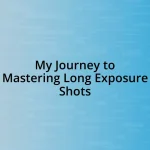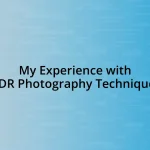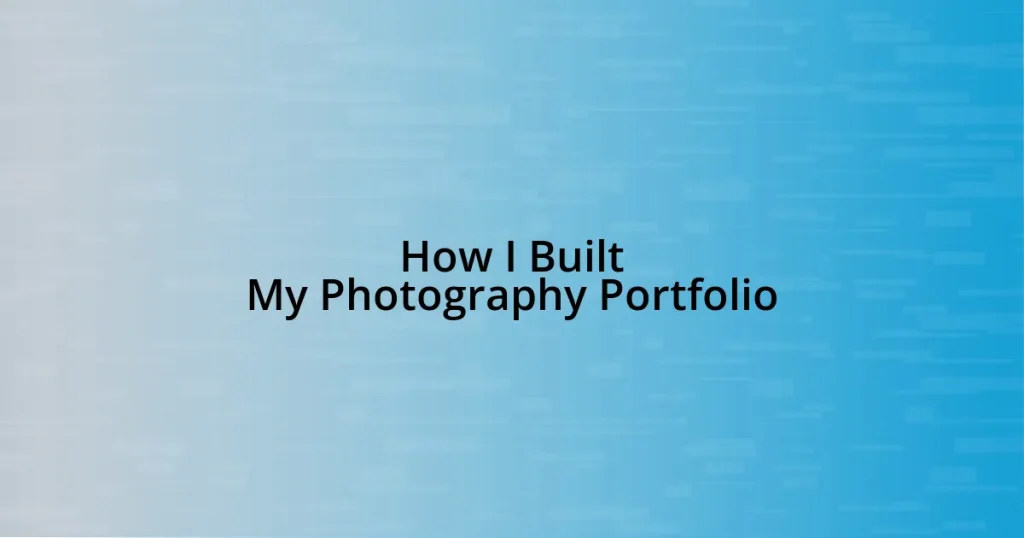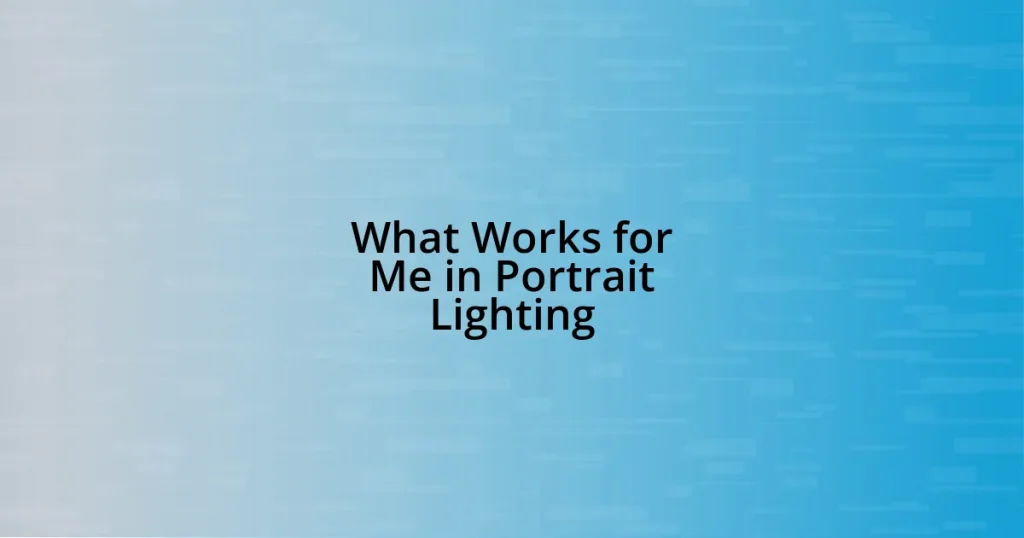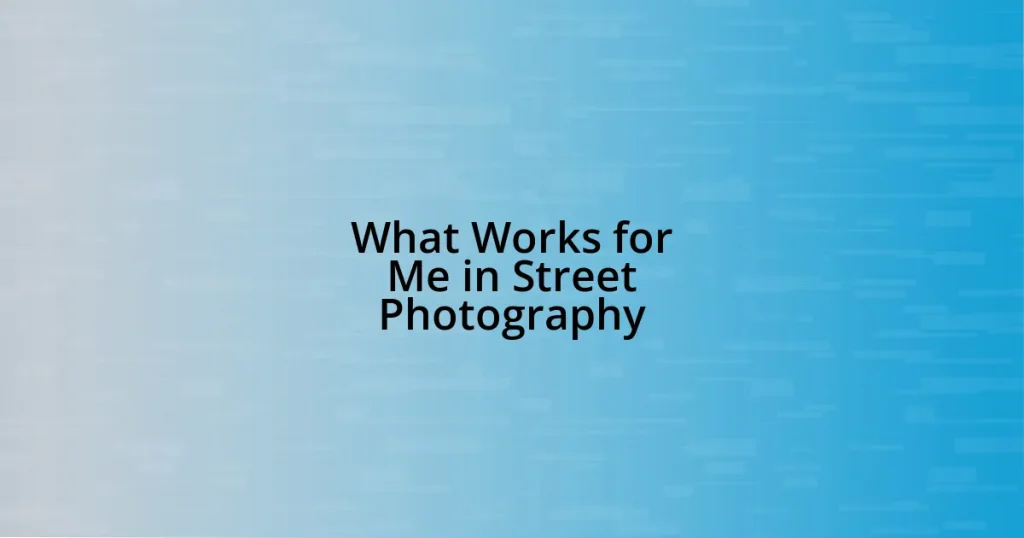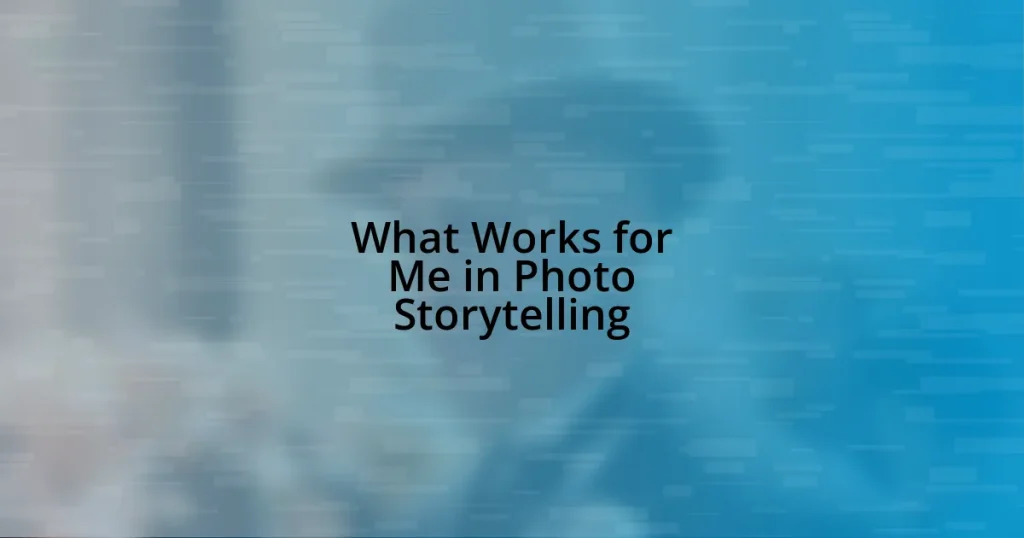Key takeaways:
- Choosing a photography niche helps define your artistic voice and fuels your passion.
- Developing a unique style involves experimentation, consistency, and authenticity.
- Building a cohesive collection enhances storytelling by weaving common themes through your work.
- Networking and engaging with fellow photographers and communities can provide valuable insights and opportunities for growth.

Choosing Your Photography Niche
Choosing your photography niche is like finding your creative voice. I still remember standing in a bustling market, camera in hand, feeling excited by the vibrant colors and dynamic scenes around me. It hit me then that street photography captured my passion for spontaneity and human connection—something that would shape my portfolio.
When I began to explore different styles, I asked myself: What moves me? It can be overwhelming to see so many options out there—portraits, landscapes, or product photography, just to name a few. I took time to experiment, and what emerged was a realization that specializing allows my personality and skills to shine, creating a distinct body of work that resonates with my artistic vision.
Don’t be afraid to reflect on your experiences and interests. What story do you want to tell through your lens? Whether it’s the serenity of nature or the chaos of urban life, selecting a niche not only helps define your portfolio but also fuels your passion. Embrace the journey; it’s in this exploration where your unique style will flourish.

Developing a Unique Style
Developing a unique photography style takes time and introspection. My journey began with experimenting not just with subjects, but also with techniques and editing styles. I vividly remember a sunset shoot, where I turned the camera toward the shadows instead of the light. That unexpected choice revealed a hidden drama in a scene I thought I knew well. Moments like that taught me that breaking away from conventions can unveil a depth to my work that’s profoundly personal and distinctive.
Here are some strategies that helped me in shaping my own style:
- Experiment with Techniques: Try different shooting methods (long exposure, macro, etc.) to see what resonates with you.
- Analyze Influences: Identify photographers or artists you admire and consider what about their work speaks to you.
- Consistency is Key: Develop a common theme or element that ties your work together, whether it’s color palettes or specific subjects.
- Seek Feedback: Share your work with a trusted circle for insights; sometimes, others can see patterns we overlook.
- Stay Authentic: Your style should reflect your personality and emotions; don’t force trends that don’t feel right.
Engaging in these practices opened doors to my signature style, making my portfolio a true reflection of who I am as both an artist and a storyteller.

Building a Cohesive Collection
Building a cohesive collection is vital for showcasing your unique voice as a photographer. I found that selecting images that speak to one another creates an emotional journey for the viewer. I remember curating a series where I juxtaposed urban and rural landscapes. That contrast not only highlighted my versatility but also added layers to my storytelling, making the collection dynamic and impactful.
To maintain cohesion, consider the common threads weaving through your work—colors, moods, or themes. I once curated a portfolio that focused solely on the color blue, featuring everything from serene seascapes to bustling city scenes at dusk. This focused approach drew the viewer in deeper, providing a cohesive experience while still allowing my individual shots to shine.
Lastly, be open to revisiting and revising your collection. I had an entire project that I initially considered complete but later realized it lacked consistency in tone. By reshuffling images and even swapping out a few pieces, I was able to create a more harmonious portfolio. Remember, it’s not about including every good photo you’ve taken; it’s about telling a compelling story through a well-thought-out selection.
| Aspect | Example |
|---|---|
| Cohesion Through Theme | Urban vs. Rural Landscapes |
| Common Visual Elements | Focus on the Color Blue |
| Revise for Consistency | Reorganizing and Swapping Images |

Selecting Showcasing Platforms
Selecting the right showcasing platforms is a crucial step in building a photography portfolio that resonates. I’ve tried various platforms, and each has its unique audience. For instance, I initially posted my work on social media, and it surprised me how much engagement I received from a casual audience. However, I quickly realized that dedicated photography websites allowed for more control over presentation and professionalism. Have you ever considered how the platform influences the perception of your work?
When I chose to create a personal website, it felt like opening a gallery of my own. I fondly remember the thrill of selecting a clean layout that emphasized visual storytelling rather than distractions. Platforms like Squarespace and WordPress offer customizable templates, which allowed me to reflect my aesthetic seamlessly. I often found myself spending hours tweaking small details just to create the perfect viewing experience. For me, a photography portfolio is not just about the photos; it’s about the emotion and narrative they convey.
I also found that niche platforms dedicated to photography can widen exposure. Websites like 500px and Behance connect you with like-minded creatives and potential clients. I shared a project on 500px that unexpectedly caught the attention of an art director. It reminded me that sometimes, stepping outside of familiar circles can lead to new opportunities. Have you explored niche communities for your work? Engaging with specialized audiences can be incredibly rewarding and help you build connections, leading to exciting collaborations.

Marketing Your Photography Portfolio
When it comes to marketing your photography portfolio, storytelling plays a pivotal role. I remember posting a series of photos from a local music festival on my blog, pairing each image with personal reflections and experiences. This narrative not only captivated my audience but also fostered a connection with them, making them more invested in my work. Have you considered how your unique stories could enhance your portfolio?
Social media has been a game-changer in promoting my photography. I’ve discovered the importance of engaging with my followers through behind-the-scenes shots and process videos. Sharing my creative journey not only humanizes my brand but also invites my audience to be a part of it. There’s something so rewarding about receiving comments from people who appreciate the effort behind each shot. How often do you interact with your audience?
Finally, don’t underestimate the power of collaboration in marketing your work. I partnered with local businesses to display my photographs, which not only expanded my visibility but also created a vibrant community connection. I often enjoy the buzz of attending art shows and seeing my work alongside talented peers. These experiences have fueled my passion—what collaborative opportunities could you pursue to elevate your portfolio?
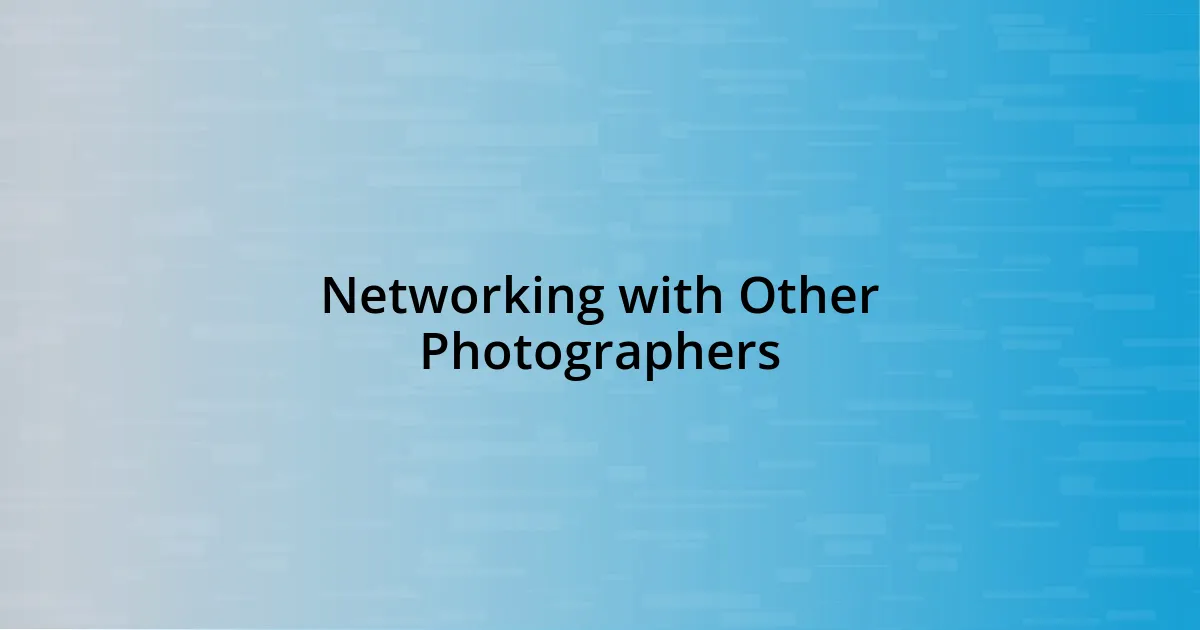
Networking with Other Photographers
Connecting with other photographers has transformed my approach to the craft. I vividly remember my first photography meetup—initially filled with anxiety, I found it exhilarating to swap ideas and techniques with peers. Have you ever taken a step outside your comfort zone to meet fellow creatives? That day fueled my motivation and passion in ways I hadn’t imagined.
I’ve learned that collaboration goes hand in hand with networking. For instance, I teamed up with a fellow photographer to shoot a local event, and it opened my eyes to new styles and perspectives. The camaraderie we developed not only enriched our portfolios but also sparked friendships that have lasted through countless projects. Have you considered how a simple collaboration could enhance your creative journey and lead to unexpected opportunities?
Engaging in online communities has also been a game-changer for me. Joining photography forums and social media groups allowed me to connect with photographers from diverse backgrounds and skill levels. I still recall sharing one of my earliest portraits in a Facebook group and receiving constructive feedback that vastly improved my technique. How has online networking impacted your growth as a photographer? It’s incredible how sharing our work and experiences can create a supportive environment where we all learn and thrive.

Evaluating and Updating Your Portfolio
When it comes to evaluating your photography portfolio, I find that revisiting it regularly can unearth new insights. I like to conduct an honest self-assessment every six months; this ritual allows me to see which images still resonate with me and which could be retired. Have you ever realized that some of your earlier work doesn’t represent who you are today? This reflection can be a powerful motivator to either embrace growth or acknowledge how far you’ve come.
Updating your portfolio is not just about adding new work; it’s also about ensuring that your collection accurately captures your style and skill progression. I remember a time when I pruned my portfolio down to my absolute favorites, leaving only those images that sparked joy and pride. It felt liberating! Sometimes, less really is more. How does your current portfolio make you feel?
Incorporating feedback is another essential part of this process. After receiving critiques at a recent photography exhibition, I realized it was time to rethink a few images in my portfolio. That conversation with a fellow artist opened my eyes to new perspectives, igniting a desire to refresh my work. Have you sought out feedback before, and what revelations did it bring? Embracing these insights can invigorate your portfolio and keep your creativity alive.






